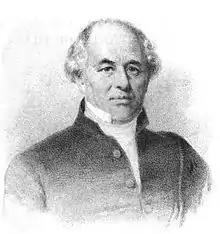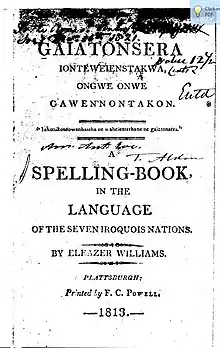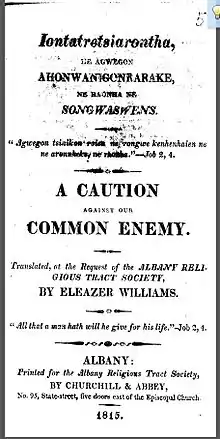Eleazer Williams
Eleazer Williams (May 1788 – August 28, 1858) was a Canadian clergyman and missionary of Mohawk descent.[1]

Williams was born in Sault St. Louis, Quebec, Canada, the son of Thomas Williams, and was educated at Dartmouth College. He published tracts and a spelling book in the Iroquois language, translated the Book of Common Prayer into Iroquois, and wrote a biography of Chief Te-ho-ra-gwa-ne-gen (Thomas Williams).
Missionary career

In 1815, Williams joined the Episcopal Church. In 1817, Bishop John Henry Hobart appointed Williams to be a missionary to the Oneida people in upstate New York.[2]
In 1820 and 1821, Williams led delegations of Native Americans to Green Bay, Wisconsin, where they secured a cession of land from the Menominee and Winnebago tribes in the Fox River Valley at Little Chute and along Duck Creek.[3] Historians have disputed the significance of Williams' leadership to this migration compared to that of the Oneida people themselves, including Oneida leader Daniel Bread.[3] The following year Williams made his home there and was married to a Menominee woman named Madeleine Jourdain. In 1826 he was ordained a deacon.[4] [5]
In 1839 and afterwards, Williams began to make the claim that he was the French "Lost Dauphin".[6] During the 1850s he openly became a pretender to the throne of France,[7] but he died in poverty at Hogansburg, New York.[4]
Williams was buried at Saint James' Cemetery in Hogansburg on August 28, 1858. In 1947, his remains and tombstone were moved to Holy Apostles Cemetery in Oneida, Wisconsin.[8] His tombstone at Oneida indicates that he was a Freemason.
Legacy
William's plot of 19 acres of land at his Wisconsin home was designated Lost Dauphin State Park by the state.[9] It was later taken off the list of state parks and the house was burned.[10] It remains designated as Lost Dauphin Park with the land remaining state owned.[11] The flagstone foundation of the house remains visible.[11]
Publications

- The book of common prayer, according to the use of the Protestant Episcopal Church in the United States of America : Translated into the Mohawk or Iroquois language, by the request of the Domestic Committee of the Board of Missions of the Protestant Episcopal Church. New-York, H.B. Durand, 1867. http://www.worldcat.org/oclc/697994178
- Gaiatonsera ionteweienstakwa, ongwe onwe gawennontakon. A spelling-book in the language of the seven Iroquois nations. Plattsburgh [N.Y.] : Printed by F.C. Powell, 1813.
- Good news to the Iroquois Nation: a tract, on man's primitive rectitude, his fall, and his recovery through Jesus Christ. Burlington, VT: Printed by Samuel Mills, 1813.

- Iontatretsiarontha, ne agwegon ahonwan igonrarake, ne raonha ne songwaswens = A caution against our common enemy. Albany [N.Y.] : Printed for the Albany Religious Tract Society by Churchill & Abbey, 1815.
- Life of Te-ho-ra-gwa-ne-gen : alias Thomas Williams, a chief of the Caughnawaga tribe of Indians in Canada. Albany, N.Y. : J. Munsell, 1859.
- The salvation of sinners through the riches of divine grace : two homilies pronounced at Oneida Castle in the audience of the Oneida Indians at their eighth triennial anniversary since the conversion of six hundred pagans of that tribe to the Christian faith : on the 8th of August 1841. Green Bay, W.T. : Printed at the Republican Office, 1842. http://www.worldcat.org/oclc/277220738
- Selections from the Psalms and hymns according to the use of the Protestant Episcopal church in the United States of America. New York, Protestant Episcopal tract Society, 1853.
References
- Hauptman, Laurence; McLester III, Gordon (2002). Chief Daniel Bread and the Oneida Nation of Indians of Wisconsin. University of Oklahoma Press. ISBN 978-0-8061-3412-3.CS1 maint: ref=harv (link)
- Hauptman 2008, p. 90.
- Hauptman 2008, p. 91.
- Williams, Eleazer 1788 - 1858.
- Phillippe 1985.
- "Eleazer Williams, Chief or the 'Lost Dauphin'?". Oshkosh Daily Northwestern. July 25, 1931. p. 2. Retrieved May 4, 2015 – via Newspapers.com.

- Wight 1903.
- "Remains of Famed Indian Missionary to Go to Oneida". Monroe Evening Times. April 22, 1947. p. 8. Retrieved May 4, 2015 – via Newspapers.com.

- "Lost Dauphin State Park". Wisconsin State Park System.
- "Oneida history". Oneida tribe. Retrieved 10 August 2017.
- Godfrey, Linda S.; Hendricks, Richard D.; Moran, Mark; Sceurman, Mark (2005). Weird Wisconsin: Your Travel Guide to Wisconsin's Local Legends.... Sterling Publishing Company. pp. 54–55. ISBN 0760759448. Retrieved August 10, 2017.
lost dauphin park.
Further reading
| Wikimedia Commons has media related to Eleazar Williams. |
- Hauptman, Laurence (2008). Seven Generations of Iroquois Leadership: The Six Nations Since 1800. Syracuse University Press. ISBN 978-0-8156-3165-1.CS1 maint: ref=harv (link)
- "Williams, Eleazer 1788 - 1858". Dictionary of Wisconsin History. Wisconsin Historical Society. Retrieved 2011-04-26.
- Sylvain, Phillipe (1985). Williams, Eleazer (Éléazar) - Dictionary of Canadian Biography Online. Dictionary of Canadian Biography Online. University of Toronto. Retrieved 2011-04-26.
- Wight, William Ward; Chicago Historical Society (1903). Eleazer Williams not the dauphin of France: a lecture read before the Chicago historical society December 4, 1902. Fergus' historical series. Fergus Printing Company. Retrieved 2011-04-26.